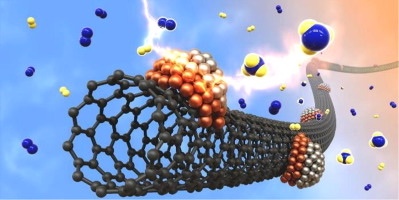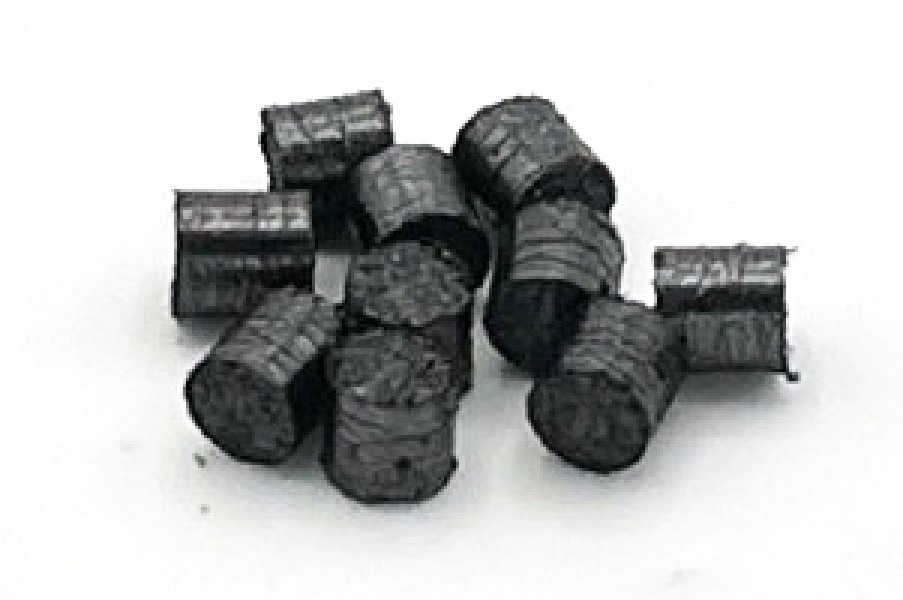

AIST:在 51 atm 和 380°C 條件下合成氨!
-負載在單壁碳納米管上的釕-
-比 Haber-Bosch 方法更低的能源成本-
國家先進工業科學技術研究院:
我們開發了一種“可以在 51 個大氣壓和 380 攝氏度下以接近平衡濃度生產氨的催化劑”。
釕負載在單壁碳納米管上。
這導致氨合成對環境的影響很小。
當前的 Haber-Bosch 方法:
在400-600攝氏度的高溫下,
在 100-300 atm 的高壓下,
合成氨。
新開發的製氨催化劑
能源消耗和成本降低
氨是由氮氣和氫氣反應合成的。
釕微粒通過銫固定在單壁碳納米管上。
直徑約為2納米。
單壁碳納米管:
由於表面積大,即使在高溫下微粒也不易凝聚,可以維持活性位點。
“在 380 攝氏度 10 個大氣壓下合成氨”,
即使你“在室溫下重複停止 2 個大氣壓 7 次”,
活動沒有下降。
獲得了在 380 攝氏度和 51 個大氣壓下接近平衡濃度的 15% 氨。
可以降低放熱反應壓力,降低能耗和成本。
新開關
AIST : Synthèse d’ammoniac à 51 atm et 380°C !
-Ruthénium supporté sur des nanotubes de carbone à paroi unique-
-Coûts énergétiques inférieurs à la méthode Haber-Bosch-
Institut national des sciences et technologies industrielles avancées :
Nous avons développé un “catalyseur capable de produire de l’ammoniac à une concentration proche de l’équilibre à 51 atmosphères et 380 degrés Celsius”.
Le ruthénium est supporté sur des nanotubes de carbone à paroi unique.
Cela conduit à la synthèse d’ammoniac avec un faible impact sur l’environnement.
Méthode Haber-Bosch actuelle :
À une température élevée de 400 à 600 degrés C,
À une haute pression de 100-300 atm,
Synthétiser l’ammoniac.
Catalyseur de production d’ammoniac nouvellement développé
Consommation d’énergie et réduction des coûts
L’ammoniac est synthétisé en faisant réagir de l’azote et de l’hydrogène.
Des microparticules de ruthénium ont été immobilisées sur des nanotubes de carbone à paroi unique via du césium.
Le diamètre est d’environ 2 nanomètres.
Nanotubes de carbone monoparoi :
Étant donné que la surface est grande, les particules fines sont moins susceptibles de s’agréger même à des températures élevées, et les sites actifs peuvent être maintenus.
“Synthèse d’ammoniac à 380 degrés C 10 atmosphères”,
Même si vous avez “répété l’arrêt à température ambiante 2 atm 7 fois”,
L’activité n’a pas baissé.
Une concentration proche de l’équilibre de 15 % d’ammoniac à 380 degrés C et 51 atmosphères a été obtenue.
La pression de réaction exothermique peut être réduite, ce qui réduit la consommation d’énergie et les coûts.
nouvel interrupteur
AIST: Synthese von Ammoniak bei 51 atm und 380°C!
-Ruthenium geträgert auf einwandigen Kohlenstoffnanoröhren-
-Geringere Energiekosten als bei der Haber-Bosch-Methode-
Nationales Institut für fortgeschrittene industrielle Wissenschaft und Technologie:
Wir haben einen “Katalysator entwickelt, der bei 51 Atmosphären und 380 Grad Celsius Ammoniak in nahezu gleichgewichtiger Konzentration erzeugen kann”.
Ruthenium wird auf einwandigen Kohlenstoffnanoröhren getragen.
Dies führt zu einer umweltschonenden Ammoniaksynthese.
Aktuelles Haber-Bosch-Verfahren:
Bei einer hohen Temperatur von 400-600 Grad C,
Bei einem Hochdruck von 100-300 atm,
Ammoniak synthetisieren.
Neu entwickelter Katalysator zur Herstellung von Ammoniak
Energieverbrauch und Kostenreduzierung
Ammoniak wird durch Reaktion von Stickstoff und Wasserstoff synthetisiert.
Ruthenium-Mikropartikel wurden über Cäsium auf einwandigen Kohlenstoffnanoröhren immobilisiert.
Der Durchmesser beträgt etwa 2 Nanometer.
Einwandige Kohlenstoffnanoröhren:
Da die Oberfläche groß ist, aggregieren feine Teilchen selbst bei hohen Temperaturen weniger wahrscheinlich, und aktive Stellen können aufrechterhalten werden.
“Ammoniaksynthese bei 380 Grad C 10 Atmosphären”,
Auch wenn Sie “den Stopp bei Raumtemperatur 2 atm 7 Mal wiederholt haben”,
Die Aktivität ist nicht gesunken.
Es wurde eine Konzentration nahe dem Gleichgewicht von 15 % Ammoniak bei 380 Grad C und 51 Atmosphären erhalten.
Der exotherme Reaktionsdruck kann reduziert werden, was den Energieverbrauch und die Kosten reduziert.
neuer Schalter
A super-growth carbon nanotubes-supported, Cs-promoted Ru catalyst for 0.1–8 MPaG ammonia synthesis
– ScienceDirect Abstract
For the decarbonization of ammonia industry, a super-growth carbon nanotube (SGCNT)-supported,
Cs-promoted Ru catalyst (Cs-Ru) was developed for mild ammonia synthesis (≤400 °C and ≤8 MPaG),
particularly under intermittent operation conditions.
This catalyst with well-dispersed Cs-promoted Ru particles
was superior to previously reported analogs in ammonia synthesis concerning activity and stability.
It produced ≈ 15 vol% of ammonia (rate ≈ 35 mmol g−1 h−1) at 380–400 °C and 5 MPaG (an H2/N2 molar ratio of 3 and a GHSV of 7000 h−1) that was close to thermodynamic equilibrium.
The active components of Cs-promoted Ru particles confined in the nanospace of SGCNTs facilitated the adsorption of hydrogen and nitrogen during the ammonia synthesis.
Hence,
it exhibited high resistance to hydrogen inhibition in H2-rich ammonia synthesis conditions,
particularly under pressurization, and facilitated nitrogen dissociation, resulting in high activity and stability in 0.1–8 MPaG ammonia synthesis at ≤400 °C.
https://www.sciencedirect.com/science/article/abs/pii/S0021951722003062